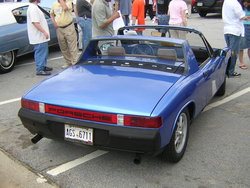Targa top

Targa top, targa for short, is a semi-convertible car body style with a removable roof section and a full width roll bar behind the seats. The rear window can be fixed or removable, making it a convertible-type vehicle. In common usage, any piece of metal or trim which rises up from the side of a car and continues in an uninterrupted line over the roof and down the other side may be called a targa band, targa bar or a wrapover band. Targa tops are different from T-tops, which have a solid, non-removable bar running between the top of the windscreen and the rear roll-bar.
The word targa first came into use from the 1965 Porsche 911 Targa, though the first production car with this system as an option was actually released five years before; namely the 1961 Triumph TR4 where it was commonly called a Surrey top. It was also used on the 1964 SAAB Catherina. The name was first adopted by Porsche after the Targa Florio road race in which they entered, used type of body style to allow a quicker entry and exit to the car by drivers in 1962 and many race cars adopted it, especially Ford and its rival at the time, Ferrari in the 1960s and early 1970s for twistier road courses.
This body style became popular in the 1960s and 1970s, when there were fears that the Department of Transportation (DOT) in the United States would ban convertibles, due to concerns over the safety of occupants when a car overturns. As a result, manufacturers adopted Targa tops or T bars. As Porsche helped to popularise this body style, they took out a trademark for the Targa name and manufacturers sought for alternative names for their removable roof.
With the introduction of the Mazda MX5 in 1989, saw a revival of convertibles as recent models had roll bar incorporated into the front windscreen, Targas and T-top witnessed a slow decline as manufacturers discontinued them one by one, in favour of full convertibles.
Glass roof
1996 saw the debut of a retractable glass roof in the Porsche 993 Targa, a design continued on the 996 Targa. The glass roof retracted underneath the rear window revealing a large opening. A shade was there to help prevent the greenhouse effect of the closed roof. This system was a complete redesign, as previous Targa models had a removable roof section and a wide B-pillar functioning as a roll bar. The new glass roof design allowed the 993 Targa to retain nearly the same side-on profile as the other 911 Carrera variants and eliminated the inconvenience of storing the removed top of the old system. The Targa had the body of the Cabriolet with the Targa glass roof replacing the fabric roof. The 911 Targa continued with the all-new 996-model and gained a lifting hatchback glass window. This, in turn, was used on the later 997 model of 911.
Examples of traditional Targa-Top
Examples of the Targa car and T-bar top body style include:
- AMC Eagle Sundancer (1980–84)
- Bugatti Veyron (2009-current)
- Chevrolet Camaro (1978–2002)
- Chevrolet Corvette coupe (1968–current) 2001–2004 and 2006+ Z06 excluded
- Datsun 280ZX
- Dodge Viper (1992–2002)
- Ferrari 250P / 250LM / 330P / 330P2 / 330P3 / 330P4 / 412P / 312P
- Ferrari 308 GTB
- Ferrari 348 TS
- Ferrari 512S/512M
- Ferrari Dino
- Ferrari F355
- Fiat X1/9
- Ford GTX-1 (1966 12 Hours of Sebring winner)
- Ford GTX-1 Roadster (2005)
- Honda CR-X del Sol
- Honda NSX-T
- Jaguar XJ-SC Cabriolet (1985–1988)
- Koenigsegg All Koenigsegg models (2004–present)
- Lotus Elise
- Maserati MC12
- Matra 530
- Mazda RX-7
- Nissan 100NX
- Nissan 300ZX
- Oldsmobile Salon (1986)
- Pontiac Firebird/Pontiac Trans Am (1976–2002)
- Porsche 904
- Porsche 906
- Porsche 911 Targa (1966–1992)
- Porsche 914
- Rover 200 Coupe (216/220)
- Saab Catherina prototype (1964)
- Smart Roadster
- Suzuki Samurai
- Suzuki Cappucino (has an optional solid roof which can be converted into a Targa top)
- Suzuki X90
- Toyota MR2 (AW11 and SW20 models)
- Toyota Sports 800 (1965–1969)
- Toyota Supra (MKIII, MKIV)
- Triumph TR4 (1961)
- TVR Tuscan